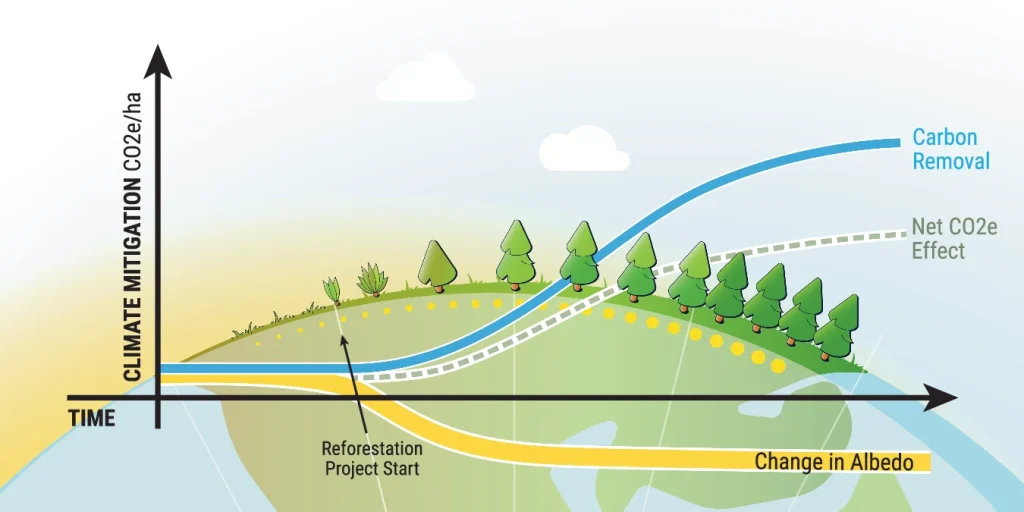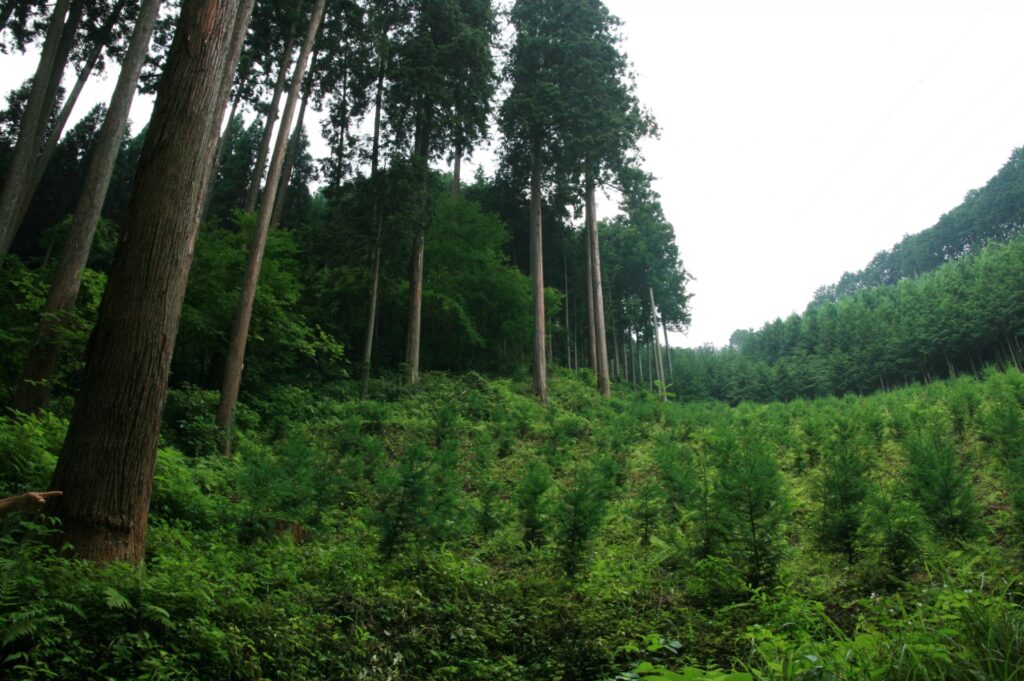- Greening = Cooling? Or Maybe Not.
- Carbon Credits Look Only at CO₂
- Albedo — When the Earth’s “Mirror” Changes, So Does Its Heat
- Another Factor — The Layer of Heat Storage and Release
- The “Greening Paradox” Shown by Recent Research
- Seeing the True Climate Effect Through a Two-Layer Lens
- The Next Era: “Radiatively Corrected” Credits
- Conclusion — To Cool the Planet, We Must See Heat as Well as Carbon
- 🔗 References
Greening = Cooling? Or Maybe Not.
Planting trees has long been portrayed as an act of environmental good — a straightforward way to halt global warming. Indeed, through photosynthesis, plants absorb atmospheric CO₂, so it feels natural to think that more trees = a cooler planet.
However, recent research is quietly revising that assumption. In fact, greening can sometimes make the Earth warmer.
The key lies in albedo (surface reflectivity) and heat storage — the physical layers of heat that can’t be explained by CO₂ alone.
Carbon Credits Look Only at CO₂
In the global carbon credit market, projects are mainly evaluated by how much CO₂ is sequestered through reforestation or grassland restoration.
- Trees grow and absorb carbon → cooling effect
- The captured carbon is traded as credits (offsets)
It’s a simple framework.
But the Earth’s temperature is not determined by CO₂ concentration alone.
Equally important is how much heat escapes from the surface into space.
That balance — between radiation (heat release) and heat storage — is what current credit systems tend to overlook.
Albedo — When the Earth’s “Mirror” Changes, So Does Its Heat
Albedo is the measure of how much sunlight a surface reflects.
Snow and sand are bright, reflecting most sunlight (high albedo).
Forests and oceans are dark, absorbing most sunlight (low albedo).
| Surface type | Approx. Albedo | Characteristics |
|---|---|---|
| Snow / Ice | 0.8–0.9 | Strong reflection (cooling) |
| Grassland | 0.2–0.3 | Moderate reflection |
| Forest | 0.1–0.15 | High absorption, easy warming |
When a bright grassland is converted into forest, the darker surface absorbs more sunlight, and the ground heats up.
This drop in reflectivity (lower albedo) causes less heat to radiate away — effectively warming the surface.

Another Factor — The Layer of Heat Storage and Release
Forests aren’t just dark; their canopies and moist soils have a high specific heat capacity, meaning they can store large amounts of heat.
Once warmed, they release that heat slowly — especially at night.
Reforestation also alters evapotranspiration (evaporation + plant transpiration), changing local air circulation patterns.
In short, greening changes how the Earth stores and releases heat.
This forms the second “thermal layer” that interacts with the atmosphere.
The “Greening Paradox” Shown by Recent Research
A 2025 Nature Communications paper, “Accounting for albedo in carbon market protocols,” analyzed 172 forest projects worldwide to quantify the impact of albedo change.
The results were striking:
- About 18% of projects overestimate their cooling effect
- About 12% show almost no net cooling or even net warming
- Roughly 9% actually gain extra cooling from increased reflectivity
In other words, planting trees doesn’t always cool the planet.
Depending on the region and ecosystem, the sign of the climate effect can flip.
Seeing the True Climate Effect Through a Two-Layer Lens
Global temperature change is governed by two interacting layers:
the radiative forcing from CO₂ and the surface thermal response (reflection + storage).
- Tropics: CO₂ absorption dominates → strong cooling
- Temperate grasslands: effects offset → near neutral
- Arid and snow-covered areas: albedo loss dominates → net warming
Without accounting for these regional efficiency differences, the real carbon balance remains hidden.
The Next Era: “Radiatively Corrected” Credits
To address this blind spot, researchers are proposing a new framework called
Radiatively Corrected Carbon Accounting.
In simple terms:
Credit value = CO₂ absorption − warming from albedo + heat storage
This adjustment ensures that only greening projects that truly cool the planet are rewarded.
In dry regions, where albedo loss is large, it may even be better not to plant.
In contrast, tropical forests still deliver clear net cooling and remain strong candidates for carbon offsets.
Conclusion — To Cool the Planet, We Must See Heat as Well as Carbon
Traditional carbon credits have focused only on the flow of carbon.
But in reality, the Earth operates through two intertwined worlds — that of carbon and that of heat.
Cutting CO₂ is vital.
But it’s equally important to ask whether our actions are reducing the planet’s ability to release heat.
The age of “plant more = cool more” is ending.
From now on, where and what kind of greenery we plant will matter far more.
To truly cool the Earth, we must understand light, heat, and carbon — together.
🔗 References
- Nature Communications (2025): “Accounting for albedo in carbon market protocols”
- NASA Earth Observatory: What is Albedo?
- IPCC AR6 WG1, Chapter 7: Physical Climate Feedbacks and Albedo Effects



コメント